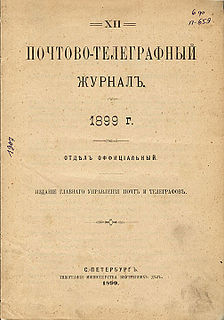This is a survey of the postage stamps and postal history of Transnistria, an unrecognized breakaway territory of Moldova and the de facto independent Pridnestrovian Moldavian Republic.
Soviet Union stamp catalogue is a national catalogue of the RSFSR and USSR postage stamps and miniature sheets, which was being published in the USSR by the “Soyuzpechat” Central Philatelic Agency (CPA) and some other publishers related to the Ministry of Communications. The catalogue usually republished in corpore around once in a 10–15 years. In between republications, additional issues came out every year. These issues contains descriptions of stamps and miniature sheets issued in USSR last year.

The Ministry of Communications of the Union of Soviet Socialist Republics (USSR) was the central state administration body on communications in the Soviet Union from 1923 to 1991. During its existence it had three names: People's Commissariat for Posts and Telegraphs (1923–32), People's Commissariat for Communications (1932–46) and Ministry of Communications (1946–1991). It had authority over the postal, telegraph and telephone communications as well as public radio, technical means of radio and television broadcasting, and the distribution of periodicals in the country.

All-Russian Society of Philatelists was the first national philatelic organisation in Soviet Russia established in 1923. Later on, it was subsequently renamed and reorganised into the All-Union Society of Philatelists and the All-Union Society of Collectors.

The First All-Union Philatelic Exhibition was held in Moscow in 1924–1925. Its full name was the First All-Union Philatelic, Scripophilic and Numismatic Exhibition. This was because it combined the objects of philately, scripophily, and numismatics.

In philately, Leniniana is a topic for collecting postage stamps that tell about the life and story of Vladimir Lenin (1870–1924) or people, places, etc. connected with him. The topic was common in the Soviet Union.
Organisation of the Commissioner for Philately and Scripophily was established in Moscow in 1922 by the All-Russian Central Executive Committee (VTsIK) for matters concerned with philately and bonds. An old Bolshevik Feodor Chuchin headed this organisation.

Soviet Philatelist or Sovetskii Filatelist was a Soviet central philatelic magazine published in 1922–1932 by the All-Russian Society of Philatelists. For a number of years, in 1925 and in 1928–1932, its name was changed to Soviet Collector or Sovetskii Kollektsioner.

War tax due stamp is a kind of war tax and postage due stamps that was used for mail when the war tax has not been paid by the sender. They were issued in Romania between 1915 and 1921.

Filateliya (Philately) or formerly Filateliya SSSR is a Russian central philatelic magazine. It first appeared in 1966 as the monthly bulletin Filateliya SSSR and was issued by the USSR Ministry of Communications. The magazine content includes the history and design of postage stamps, and other related themes.

Kollektsioner or formerly Sovetskii Kollektsioner is a Russian central philatelic yearbook. This annual publication started in 1963 and covered the history and design of postage stamps, and other related topics.

Moscow Society of Philatelists and Collectors was one of the first philatelic organisations in Soviet Russia that appeared in Moscow in 1918. Later on, it ceased and was replaced with the All-Russian Society of Philatelists.

Moscow Society of Stamp Collectors was one of the first philatelic organisations in the Russian Empire that was created in Moscow in 1883. Later on, it was dissolved and restored in 1907.

Russian Bureau of Philately was a special organisation under the People's Commissariat for Posts and Telegraphs of the RSFSR in 1921–1924. This was the first Soviet government agency in charge of all matters of the organisation and development of philately.

The A.S. Popov Central Museum of Communications is a museum of science and technology founded in 1872. It is located in the historic centre of Saint Petersburg, Russia, near Saint Isaac's Square.

The People's Commissariat for Communications of the USSR was the central state agency of the Soviet Union for communications in the period 1932 to 1946. The Commissariat administered the postal, telegraph and telephone services.

People's Commissariat for Posts and Telegraphs of the USSR was the central organ of the Soviet Union government that was in charge of the organisation and administration of the different forms of communication including posts. It existed between 1923 and 1932.

Pochtovo-Telegrafnyi Zhurnal was an official magazine of the Russian postal authorities between 1888 and 1919.

Matvey Kuzmich Lyubavsky was a Russian and Soviet historian, professor, academic and rector of the Moscow University from 1911 to 1917.
































